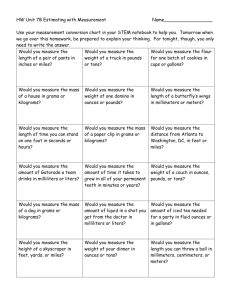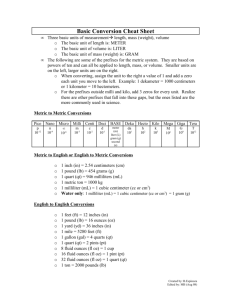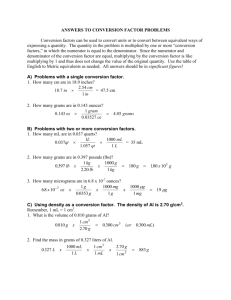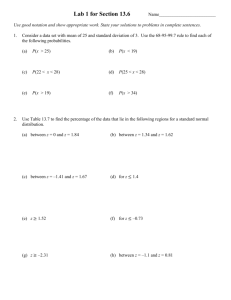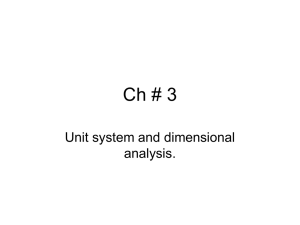Worksheet #1 - Math Online - WELCOME to the Online Math at
advertisement
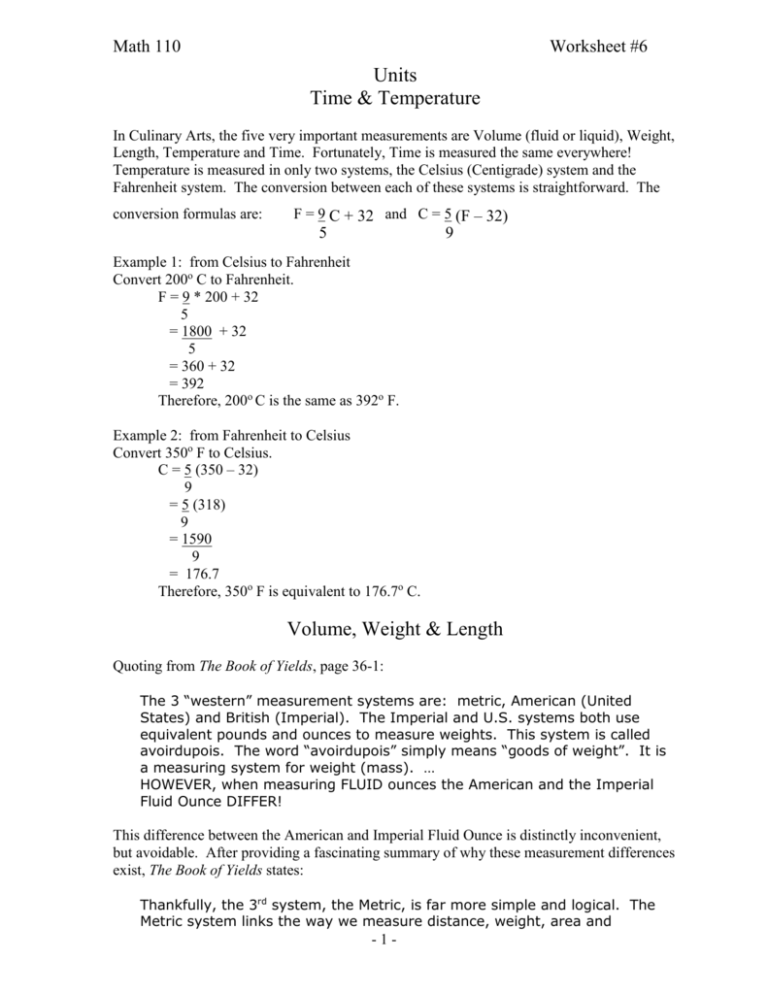
Math 110 Worksheet #6 Units Time & Temperature In Culinary Arts, the five very important measurements are Volume (fluid or liquid), Weight, Length, Temperature and Time. Fortunately, Time is measured the same everywhere! Temperature is measured in only two systems, the Celsius (Centigrade) system and the Fahrenheit system. The conversion between each of these systems is straightforward. The conversion formulas are: F = 9 C + 32 and C = 5 (F – 32) 5 9 Example 1: from Celsius to Fahrenheit Convert 200o C to Fahrenheit. F = 9 * 200 + 32 5 = 1800 + 32 5 = 360 + 32 = 392 Therefore, 200o C is the same as 392o F. Example 2: from Fahrenheit to Celsius Convert 350o F to Celsius. C = 5 (350 – 32) 9 = 5 (318) 9 = 1590 9 = 176.7 Therefore, 350o F is equivalent to 176.7o C. Volume, Weight & Length Quoting from The Book of Yields, page 36-1: The 3 “western” measurement systems are: metric, American (United States) and British (Imperial). The Imperial and U.S. systems both use equivalent pounds and ounces to measure weights. This system is called avoirdupois. The word “avoirdupois” simply means “goods of weight”. It is a measuring system for weight (mass). … HOWEVER, when measuring FLUID ounces the American and the Imperial Fluid Ounce DIFFER! This difference between the American and Imperial Fluid Ounce is distinctly inconvenient, but avoidable. After providing a fascinating summary of why these measurement differences exist, The Book of Yields states: Thankfully, the 3rd system, the Metric, is far more simple and logical. The Metric system links the way we measure distance, weight, area and -1- Math 110 Worksheet #6 volumes. Being consistent, the Metric system is used to compare the U.S. and Imperial systems to each other. The Metric system does indeed simplify your life and mine! We can use the metric system to convert between each system. However, we are going to concentrate just on the U.S. and Metric systems of measurements. In Culinary Arts, you frequently convert from one unit to another. Sometimes you work with weights such as ounces and pounds (US) or grams, decigrams and kilograms (Metric). Sometimes you work with liquid volumes such as cups, quarts and gallons (US) or milliliters, centiliters or kiloliters (Metric). Often food is bought by weight, but chefs prefer to use the food with volume measures as it makes recipes easier to follow. Also in Culinary Arts, you need to determine the quantity of a food sold by weight measures, so you can order the correct amount for a recipe using volume measures or sold by volume when using a recipe giving ingredients by weight. Bakers usually use weight measurement, as this tends to keep recipes more consistent and accurate. Finally, sometimes it is necessary to convert from the U.S. units to the metric units or vice-versa. In Culinary Arts, the Volume units (cubic inches, cubic centimeters, etc.) are not used very often and will not be discussed here. What is used in the Culinary Arts field is Fluid Volume. Fluid Volume is also called Capacity and is used all the time. Fluid Volume or Capacity is used when measuring liquids. Here are some standard U.S. and metric measurement conversions. These tables are by no means exhaustive. (This is just a taste of conversions…) U.S. Measures of Fluid Volume (Capacity)_ ½ pinch ~ 1/8 teaspoon (tsp or t) 3 teaspoons = 1 tablespoon (tbsp or T) 16 tablespoons = 1 cup (C) 2 cups = 1 pint (pt) 2 pints = 1 quart (qt) 4 quarts = 1 gallon (gal) U.S. Measures of Weight (Mass) 16 ounces (oz) = 1 pound (lb) 2000 pounds = 1 ton U.S. Measures of Length 12 inches (in) = 1 foot (ft) 3 feet (ft) = 1 yard (yd) 5280 feet = 1 mile (mi) U.S. Capacity (Fl. Vol.) to Weight (Mass) 1 fluid Cup = 8 ounces Metric Measures: Capacity(Fl. Vol.) kiloliter = kl hectoliter = hl dekaliter = dal liter = l deciliter = dl centiliter = cl milliliter = ml Mass (Weight) kilogram = kg hectogram = hg dekagram = dag gram = g decigram = dg centigram = cg milligram = mg Length kilometer = km hectometer = hm decameter = dam meter = m decimeter = dm centimeter = cm millimeter = mm The conversion is done by relocating the decimal. Review topic F6 to remind yourself of how to use the prefix table to change a measurement from one unit to another unit within the metric system. -2- Math 110 Worksheet #6 k kilo- h hecto- Prefix Table: da deka- basic d deci- c centi- m milli- no prefix Remember: the liter measures liquid volume; the gram measures mass (weight); the meter measures length. Fluid Volume (Capacity) – U.S. & Metric Conversions 1 fl. oz = l fl. gal. = 1 ml = 1l = 29.5735 ml 3.78541 l .033814 fl. oz. .26417 gal. Recall, avoirdupois (avdp) means the measure is a weight, not volume. Avdp helps us distinguish between the U.S. fluid ounce (volume) and the U.S. ounce (weight). The U.S. fluid ounce (volume) is 1.22 grams heavier than the U.S. ounce weight. This is confusing. So if you see fluid ounces, you know the reference is to volume. If you see ounces (avdp) you know the reference is to weight. If you see just ounces, you will have to carefully look at the context to determine whether the recipe is referring to weight (avdp) or volume. Fluid Volume (Capacity) to Mass - U.S. & Metric Conversions 1 fl. C = 8 ounces (avdp) 1 fl. C = 236.6 g Weight (Mass) - U.S. & Metric Conversions 1 ounce (avdp) 1 pound (advp) 1 kg 1 kg = = = = 28.34952 g 453.592 g 35.27396 ounces (avdp) 2.2046 pounds (avdp) NOTE: 8 ounces (avdp) = 226.796 g. 8 fluid ounces = 236.6 g Length - U.S. & Metric Conversions 1 in. = 2.54 cm 1 ft = 30.48 cm 1 cm = .3937 in. 1 m = 39.37 in. Few examples/problems of conversions within each measurement system will be given as these problems are explained in Topic F6.1 online at the Academic Systems’ website and in the homework from your Personal Academic Notebook (the textbook). Most of the problems will involve converting between the two systems, U.S. and Metric. A few will involve converting all units in a recipe to measures of weight. Example3: converting from metric to U.S. units -3- Math 110 Worksheet #6 The ingredients listed for a recipe for “Sautéed Sole with Preserved Mango Chutney and Grilled Bananas” (taken from Techniques of Healthy Cooking, page 347) are listed below. Convert the recipe to the appropriate U.S. units. 1 kilogram 40 milliliters 30 grams 3 grams 450 grams 700 grams Sole fillets, trimmed Skim milk Bread crumbs, dry Butter, whole, unsalted Preserved Mango Chutney Bananas, sliced on bias, grilled For the trimmed sole fillets: Since 1 kilogram = 35.27396 ounces (avdp), 1 kg * 35.27396 oz (avdp) = 35.27396 oz(avdp) 1 kg so 35.27396 oz(avdp) * 1 pound (avdp). ~ 2.2 pounds (avdp) or 2¼ lbs (avdp) 16 ounces (avdp) (Note: “~“ means “approximately equals”.) OR For the trimmed sole fillets: Since 1 pound (avdp) = .453592 kg, 1 kg * 1 lb (avdp) ~ 2.2 pounds (avdp) .453592 kg Notice that if you have any relationship, then you can write the ratio unit for conversion. Now let’s finish converting the rest of the ingredients on our list to U.S. units. For the skim milk: Since 1 ml = .033814 fl. oz., 40 ml * .033814 fl.oz. ~ 1.4 fl. oz. (or perhaps, 1½ fl oz) 1 ml For dry bread crumbs: Since 1 oz (avdp) = 28.34952 g, 30 g * 1 oz (avdp) ~ 1 oz (avdp) 28.34952 g For whole, unsalted butter: Since 1 fl. C. = 236.6 g and 1 fl C = 16 tbsp, 30 g * 1 fl. C * 16 tbsp ~ .2 tbsp 236.6 g 1 fl C Since 3 tsp = 1 tbsp, .2 tbsp * 3 tsp = .6 tsp or ~ ½ tsp 1 tbsp For preserved mango chutney: Since 1 lb = 453.593 g, 450 g * 1 lb (avdp) ~ 1 pound (avdp) 453.592 g For the bananas: Since 1 lb = 453.592 g, -4- Math 110 Worksheet #6 700 g * 1 lb (avdp) ~ 1.5 pound (avdp) 453.592 g So the converted recipe is now: 2.2 pounds 1.4 fluid ounces 1 ounce ½ tsp 1 pound 1½ pounds Sole fillets, trimmed Skim milk Bread crumbs, dry Butter, whole, unsalted Preserved Mango Chutney Bananas, sliced on bias, grilled Problems 1. Convert this recipe for “Wild Rice Salad” (taken from Techniques of Healthy Cooking, page 259) to the appropriate U.S. units. 450 grams As needed 150 milliliters 140 grams 140 grams 60 grams 45 milliliters 15 grams 15 grams 1 gram Wild rice Stock or water Vinaigrette Granny Smith apples, cored, julienne Red pepper, julienne Walnuts, toasted Apple Cider Shallots, minced Garlic, minced Sage leaves, chopped 2. The recipe for “Fresh Tomato Salsa” (taken from Techniques of Healthy Cooking, page 225) is given in metric units. Convert this recipe to pounds and ounces. 450 grams 30 grams 85 grams 15 grams 15 milliliters Tomato concassé Jalapeño pepper, minced Red onion, minced Cilantro, fresh, chopped Lime juice, fresh 3. The Fresh Tomato Salsa in problem #2 makes a good accompaniment to a variety of Southwestern or Tex/Mex dishes. It is also excellent when served with grilled fish, meats or poultry. If a typical portion is about 3 ounces, what is the yield for the above recipe? 4. A recipe for Chicken Scallopini with Mushrooms and Capers (also from our favorite cookbook, Techniques of Healthy Cooking, page 348) is given in U.S. units. Convert this recipe to metric units. 2¼ pounds 2¾ ounces 2¾ ounces Chicken breast, boneless, skinless Butter, unsalted Flour -5- Math 110 Worksheet #6 1 pound, 2 ounces 7 ounces 8 fluid ounces 26 fluid ounces 2¼ pounds Mushrooms, sliced Capers, drained, rinsed Sherry Fond de Veau Lié Zucchini noodles 5. Praliné is frequently used to flavor fillings and ice creams. The ingredients used in a recipe for “Praliné” from Mastering the Art of French Pastry, page 414, are given below. Convert to metric units of weight. How many grams of Praliné will this recipe yield? 7 ounces 7 ounces 1 cup 1½ cups Raw almonds Hazelnuts Sugar Confectioners sugar 6. a. The following ingredients are for “Dessert Crepes” from Desserts and Beverages, page 239. Convert the recipe to metric units. b. One crepe takes about 39 grams of batter. What is the recipe yield? 2 2 1C ¼ tsp 1¼ C 1 tsp 1 tsp 1 Tbsp Eggs Egg Yolks Flour Salt Milk Orange Rind, grated Cointreau Liqueur Butter or Margarine, melted 7. This recipe is for “Preserved Mango Chutney” from , Techniques of Healthy Cooking, page 229. Find the food cost for this recipe. 1 kg 200 g 170 g 140 g 30 g 10 grams 30 ml 1 15 g 15 g 750 mg 500 mg Mango, fresh, diced Brown sugar Onion, diced Raisins Walnuts, chopped Garlic, minced Cider vinegar Lemon, juice and zest Ginger, minced Jalapeño pepper, minced Mace, ground Cloves, ground 12 count per case (11 lb) at $7.45 per case 50-lb bag for $25.03 (yellow) 50-lb bag for $5.40 (golden) 30-lb case for $25 (92% yield) (halves & pieces) 30-lb box for $85.74 (peeled) $8.85 for 5 lbs 1 gal for$6.52 140 for $32.30 15-oz jar for $10.46 (whole) $1.15 per lb (100% yield) 16-oz jar for $11.85 16-oz jar for $15.58 8. In example 3, we converted the ingredient for “Sautéed Sole with Preserved Mango Chutney and Grilled Bananas” from metric units to U.S. units. Below are listed again the results of our conversions. Also listed are the costs of the ingredients. a. Find the food cost per portion if the recipe yield is 10 portions. b. If the food cost percent is 62%, what is the selling cost for one portion. c. What is the mark-up rate? -6- Math 110 Worksheet #6 2.2 pounds 1.4 fluid ounces 1 ounce ½ tsp 1 pound 1½ pounds Sole fillets, trimmed Skim milk Bread crumbs, dry Butter, whole, unsalted Preserved Mango Chutney Bananas, sliced on bias, grilled $3.38 per lb (80% yield) 1 gal for $2.47 (Panko crumbs) $.98 per lb 1 case (55.11 lb) for $79.90 see problem #7 above $.65 per lb (66.3% yield) 9. This recipe is for “Oatmeal Cookies” from , Techniques of Healthy Cooking, page 550. One cookie takes 1 tsp of the batter. If the mark-up rate is 62%, what is the selling price for one dozen cookies? 14 oz 120 g 15 g 30 g 15 ml 5 ml 140 g 115 g 100 g Sugar, brown Honey Butter, unsalted Egg whites Evaporated skimmed milk Vanilla extract Oats, quick cooking Flour, all purpose dried pears, small diced 50-lb bag for $25.03 7.5-lb jug for $12.35 1 case (55.11 lb) for $79.90 (frozen) 1 carton (5 lb) for $5.07 12-oz can for $.91 *(dark, imitation) 1 gal (8 lb) for $16.14 50-lb bag for $16 50-lb bag for $9.08 25-lb case for $38.88 * Pure vanilla extract is 1 gal (9 lb) for #113.89. Use imitation vanilla extract here! 10. The recipe for “Chocolate Polenta Soufflé” is in the Techniques of Healthy Cooking, page 530. Each soufflé is dusted lightly with powdered sugar and served with a sauce made by flavoring the dairy base with an appropriate liqueur or cordial. Say the cost of the powdered sugar and sauce are $.67 per soufflé. Below are the ingredients and costs. The recipe yields 10 portions. What is the selling price for one portion if the mark-up rate is 45%? 20 fl. oz 1 oz 4 oz 3 oz 1 oz 1 3/4 oz 6 Skim milk Orange peel Sugar, granulated Cornmeal Cocoa powder Grated baking chocolate Egg whites -7- 1 gal for $2.47 1 lb for $.55 (Baker’s) 50-lb for $22.98 25-lb bag for $10.73 (Dutch) 50-lb bag for $86.25 (Semi-sweet) 55-lb bar for $192.50 (frozen) 1 carton (5 lb) for $5.07 (say 2 tbsp = 1 egg white)

